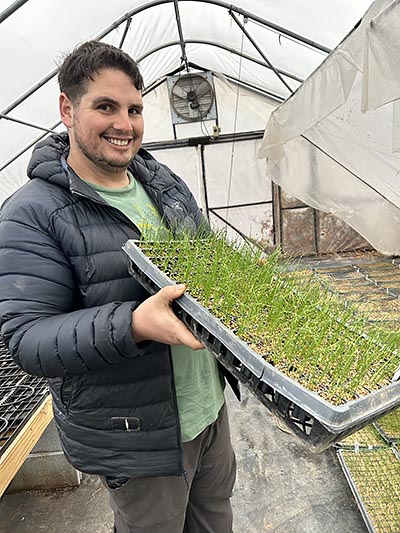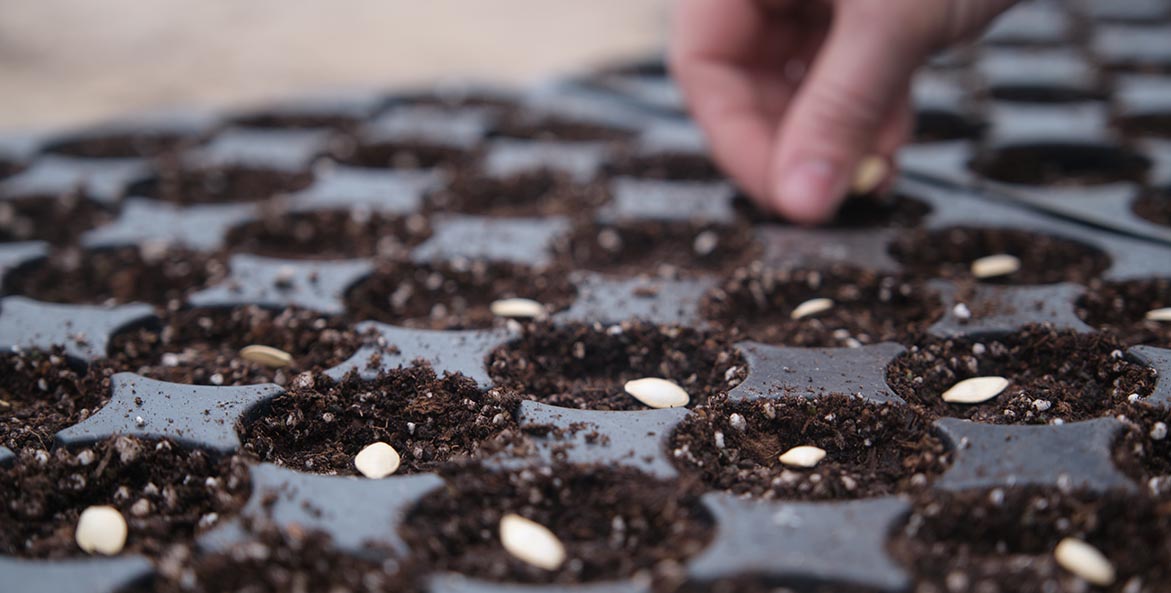The trees are bare and the grasses brown, but in a small patch of sunshine that falls on a neat stack of hives, the bees are buzzing. They’ve started venturing outside on these unseasonably warm February days, say Jared and Elissa Planz, who manage the vegetable production and distribution operations at CBF’s Clagett Farm in Upper Marlboro, Maryland.
Soon, the farm will be buzzing, too. In the strawberry fields, trios of fresh green leaves push forth among last year’s crisped and curled ones. They, like the bees, have been coaxed out by the unusual warmth (something of a worry to the farm crew, who last year tried to save the crop from a late frost by pinching early -blooming flowers from the plants one by one). Bluebirds already flash among the trees and fenceposts, preparing to build nests in the freshly -cleaned nest boxes. And in the rolling pastures, three-week-old calves tiptoe alongside their mothers.
People sometimes think of food and farming and nature like it’s all separate behind glass walls. But it isn’t. We’re all part of it.
“All of this is connected into one system of life,” says Jared. “If there is one thing I want people to remember when they leave here, it’s that.”
One might ask what farming has to do with restoring the Chesapeake Bay. It turns out, that ‘system of life’ matters a whole lot. Agriculture is the second -largest land use in the Chesapeake watershed, and runoff from farms is the largest source of pollution to the Bay and many local streams. But when farms operate in a way that creates healthy soils and ecosystems, they can be powerful engines for change.
Clagett Farm is a place to ground-truth how holistic farm systems, often termed ‘regenerative agriculture,’ can help improve soil and water quality. It’s important to note that these systems aren’t new—they’ve been practiced for thousands of years by Indigenous and Black societies—yet they are currently rare in the U.S. food system. Changing the course of water quality in the Chesapeake Bay could well depend on more farmers adopting this type of farming.
Right now, Jared, Elissa, and the rest of the farm team are busy preparing for the growing season. Each year, farm staff and volunteers grow thousands of pounds of organic produce here, as well as raise pasture-fed cattle and sheep. Much of the harvest goes to roughly 250 community shareholders who subscribe to the farm’s Community Supported Agriculture (CSA) program, while approximately 30 percent is donated to the Capital Area Food Bank and the Prince George’s County Food Rescue.

Clagett Vegetable Production Manager Jared Planz shows off a winter flat of healthy onion seedlings.
CBF Staff
CSA sales kicked off this week, and flats upon flats of tiny onion plants are already sprouting thin green tendrils in the farm’s hoop house. Nearby, so too are thousands of native tree seedlings—many grown from seeds collected on the farm itself—that will be planted at restoration sites across Maryland to help buffer streams from pollution.
“Soon we’ll be starting our collards and kale,” Elissa explains.
Eventually, the seedlings will be planted out in the fields. But for now, those fields are mostly full of other types of vegetation. Broadly known as cover crops, these plants help keep the soil in place and store nutrients like phosphorus and nitrogen, preventing them from washing away into streams whenever it rains or snows. In this way, they cut down on pollution.
Different species also provide many other benefits to the soil and the crops that will come later, reducing the need for fertilizers and tilling. Farm staff are continually assessing and adjusting based on what a given field needs—whether it be nitrogen-fixers like white clover to add back nutrients or deep-rooted daikon radishes that naturally ‘till’ the soil.
“This is really what we’re all about,” Jared says, holding up a handful of soil.
If the soil is healthy, it is full of microbes that munch and cycle nutrients and macroinvertebrates like worms that help breakdown organic matter and create space for water to filter into the ground. To help determine the soil’s health, farm staff take regular soil samples. They also keep track of the farm’s nutrient management plan to ensure no nutrient is applied in excess.
They typically don’t have to worry about applying too much fertilizer, though. Frequently rotating the cattle and sheep among pastures spreads manure naturally. Cover crops help add nutrients and organic matter back into the soil, as well as keep down weeds. Insects-loving birds, like bluebirds, help control pests.
Managing it all is a delicate balancing act that requires significant attention to detail—and, often, trusting your gut, Jared says. These are things farmers have been doing for thousands of years, but sometimes they get lost as the modern food system pushes farms to be bigger and more mechanized.
One of the farm staff’s biggest goals is to simply connect people with their food and this complex web that ties together people, land, water, and wildlife. Throughout the coming months, the farm will host students and policymakers, employees from corporate businesses, and other farmers looking to learn about grazing and soil health. It will also be a gathering place for community members and volunteers to come and celebrate the simple bond of good food grown well.
“People sometimes think of food and farming and nature like it’s all separate behind glass walls,” Elissa says. “But it isn’t. We’re all part of it.”




